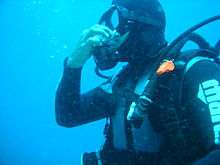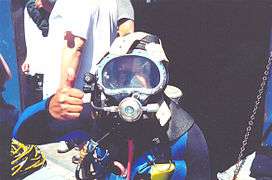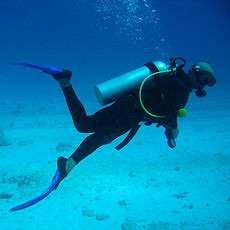Diving mask
 Snorkeler wearing a clear silicone diving mask | |
| Other names |
|
|---|---|
| Uses | Provides clear underwater vision for divers |
| Related items | Full-face mask, Swimming goggles |
A diving mask (also half mask, dive mask or scuba mask) is an item of diving equipment that allows underwater divers, including, scuba divers, free-divers, and snorkelers to see clearly underwater.[1][2] Surface supplied divers usually use a full face mask or diving helmet, but in some systems the half mask may be used.[2] When the human eye is in direct contact with water as opposed to air, its normal environment, light entering the eye is refracted by a different angle and the eye is unable to focus the light. By providing an air space in front of the eyes, light enters normally and the eye is able to focus correctly.
Construction
There are two basic categories of diving mask: The half mask covers the eyes and nose, and the full face mask covers eyes, nose and mouth, and therefore includes a part of the breathing apparatus. The half mask is described here.
Diving masks may have a single, durable, tempered glass plate, or two lenses in front of the eyes and a "skirt" of synthetic rubber or silicone elastomer to create a watertight seal with the diver's face.[1] Some masks with two lenses allow the user to fit prescription lenses directly into the frames, otherwise it is possible to have prescription lenses glued to the inside of the original flat glass, either full frame, or partial, which function as bifocals. In the case of freediving masks, which need to be low volume to minimize the amount of breath needed to equalize the change of pressure that occurs with depth, the lenses may be made of polycarbonate plastic. All masks have means to keep them in position, such as an elastic rubber strap[1] or a velcro fabric strap.
The elastomer skirt provides a seal between the lenses and the diver's face. The material may be almost transparent, translucent or opaque. A nearly transparent skirt provides a greater peripheral vision, though somewhat distorted, and may reduce the feeling of claustrophobia in some divers, but in some cases the light entering through the sides may cause distracting internal reflections. The skirt also encloses the nose, usually by means of a nose pocket, so that air can be exhaled into the mask to equalise the pressure during descent. A rigid frame may be used to connect the lens(es) to the skirt, or they may be permanently bonded together without using a frame.
Masks that are used at depth must be constructed so that the diver can exhale through the nose into the mask to prevent the "squeeze" caused by increasing pressure during descent in water.[3] The nose section of the mask also needs to be flexible to allow the diver to block the nostrils to perform a maneuver such as the valsalva maneuver or the frenzel maneuver when equalising pressure in the middle ear.
Some masks have a one-way purge valve under the nose to let water out. While common in snorkeling, this feature is less favored by scuba divers because of the possibility of the valve failing at depth and leaving the user with a leaking mask.
Divers may test whether a mask is a good fit by placing it on their face, without using the straps, and gently inhaling through their nose. If the mask stays on without any help this indicates that no air is being drawn in and that the fit is good.
The straps are usually made of an elastomer that can sometimes cause hair tangling. This can be prevented by replacing the rubber strap with a customized neoprene strap or by covering the existing strap with a neoprene cover.
Sometimes masks are sold in conjunction with snorkels and/or swimfins. Low quality snorkelling masks may have a low-quality plastic or glass faceplate, and are not recommended for anything but rare, casual use. Masks that have the snorkel built in are considered hazardous as well.
Function
Refraction of light entering the mask makes objects appear about 34% bigger and 25% nearer when underwater.[4] As the diver descends in clean water, the water acts as a colour filter eliminating the red end of the visible spectrum of the sunlight entering the water leaving only the blue end of the spectrum. Depending on the depth and clarity of the water, eventually all sunlight is blocked and the diver has to rely on artificial light sources to see underwater.
A variety of prescription lenses can be fitted inside the glass plate of the mask to correct some visual problems underwater.[5] Divers may be able to use contact lenses inside the mask but they may need to keep their eyes closed if they remove the mask underwater to avoid losing the lenses. Double-dome masks restore natural sized underwater vision and field of view, while also correcting for a certain range of myopic vision.
Use
To prevent a mask from fogging up due to condensation on the glass plate many divers spit into the dry mask before use, spread the saliva around the inside of the plate and rinse it out with a little water. The saliva residue allows condensation to wet the glass and form a continuous film, rather than form droplets. There are commercial products that can be used as an alternative to the saliva method, some of which are more effective and last longer.
Mask removal and refitting underwater is a basic skill that all divers are taught so that the diver can overcome floods or the mask being dislodged without panic. The strap can be adjusted to suit the diver's head. Too loose may not provide an effective seal and the mask may dislodge easily, and too tight may result in discomfort or pain. Correct positioning of the strap around the back of the head will reduce the risk of dislodging and facilitate clearing.
Wearing the mask pushed up onto the forehead while out of the water or on the surface increases the risk of the mask falling or being knocked off and possibly being lost.
When entering the water while wearing the mask, the diver may need to place a hand over the mask to prevent water flow from dislodging or knocking off the mask. Alternatively, a diver can enter the water with the mask off and then put it on or use an entry method such as the "forward roll", where the diver rolls forward with head entering the water first, which does not result in fast water flow over the mask.
Standard maintenance is to rinse inside and out with clean, fresh water after each day's use, and dry out of direct sunlight before storage. Ultraviolet light degrades the synthetic materials of the skirt and frame. A well-maintained mask should last for several years. The strap is the most stressed component and is often the first part to fail. Inspection of the strap for cracks and tears before use can reduce the risk of failure during a dive.
Mask clearing
.jpg)
It is quite common for water to leak into the mask, which can be annoying, or interfere with clear vision, and the diver needs to be able to get rid of the water quickly and effectively. Reasons for the leakage include poor fit or fitting, leaking via head or facial hair, movement of the facial muscles causing temporary leaks, or impact of external objects against the mask, which may distort it temporarily, or move it so that it leaks, or in extreme cases dislodge it entirely from the diver's head.
The methods of clearing differ between the half mask, which covers the eyes and nose, and the full-face mask, which also covers the mouth.
A simple and effective method for clearing a diving half mask while underwater is to press the top of the frame against the forehead, and look slightly upwards while exhaling through the nose, which forces the water out at the bottom of the mask. If the mask has a purge valve and the strap tension is correct, the diver simply holds the face so that the valve is at the lowest point and exhales through the nose.
Equalizing

The pressure changes during ascent and descent may affect gas spaces in the diver and diving equipment. A change in pressure will cause a pressure difference between the gas space and environment which will cause the gas to expand or compress if that is possible, and constraining the gas from expanding or compressing to balance the pressure may cause damage to the surrounding material or tissues by over-expansion or crushing. Some gas spaces, such as the mask, will automatically release excess gas as it expands during ascent, but have to be equalized during compression of descent.
Equalizing of the mask is an essential skill for any form of diving. Goggles that do not cover the nose can not be equalised and are unsuitable for diving. The mask is equalised by exhaling sufficient air through the nose to provide a balanced internal pressure. Any excess will simply leak out around the skirt.
Equalising (or clearing) the ears is necessary to prevent barotrauma to the middle and inner ear. Some divers need to pinch the nostrils closed as part of their equalisation technique, and this must be allowed for in the design of the mask skirt.
Types of diving mask
 Older diving mask with one big window
Older diving mask with one big window Disassembled single-window, low-volume dive mask
Disassembled single-window, low-volume dive mask A two-window, soft-silicone dive mask without purge valve
A two-window, soft-silicone dive mask without purge valve A HydroOptix Double-Dome mask
A HydroOptix Double-Dome mask- Mask with bifocal lenses for reading instruments
- A diving mask showing the retaining strap
 A twin-lens, low-volume diving mask, Aqua Lung (Technisub) Sphera, with wide peripheral view of the type favoured by many Underwater Hockey players.
A twin-lens, low-volume diving mask, Aqua Lung (Technisub) Sphera, with wide peripheral view of the type favoured by many Underwater Hockey players.
Early model diving masks had a single elliptical pane of glass. These masks have indentations in the skirt at the bottom on either side of the nose, into which the diver can insert a thumb and forefinger to pinch the nose, when performing a Valsalva maneuver to clear their ears. This design was improved by bringing the window closer to the face, reducing the volume of air inside the mask, thus making mask clearing easier. The window has a cutout to fit around the nose, which is covered by the rubber or silicone material of the skirt. This facilitates pinching the nose when ear-clearing.
A further development is the mask with two windows, one for each eye. It can have the windows closer to the face than the one-window type, and therefore contain even less internal volume for the diver to clear or equalise. These types are often called a "low-volume mask". Participants in the sport of underwater hockey are required to use twin-lens masks of this type for their own safety - the sport uses a heavy lead puck similar to an ice hockey puck, nan but skilful players can flick the puck considerable height off the bottom when making passes which leads to the possibility of accidental puck contact with other players. Should a puck hit the lens of a single-lens mask there is a good chance it will break the glass and pass through the aperture to hit the face and eyes, but with a twin-lens mask though the glass may break the frame will prevent the passage of the puck any further.
Recent innovations have produced more complex designs, intended to provide extra features:
- The double-dome mask. This was invented by HydroOptix. Double-dome masks allow a wider field of view and avoid the refraction error in perceived distance and size of objects. Underwater the curved mask windows make the diver's vision effectively more hyperopic, or less myopic, and the diver must wear special contact lenses to compensate (unless his eyes are myopic to the right amount to compensate exactly for the refraction at the curved mask windows). The diver's vision will become myopic when he puts his head out of water with the contact lenses in.[6]
- The "Data Mask", developed by Oceanic, is a half mask with a built-in LCD head up display which displays various dive and breathing set conditions including the function of a diving computer. It is currently very expensive.[7]
Related equipment

There are several specialised types of diving headgear or outerwear:
- full face diving mask - often worn by working divers who need underwater verbal communication ability.
- Lightweight diving helmet - usually worn by divers using surface supplied diving equipment.
- Copper hat - part of the old fashioned standard diving dress.
- fluid filled mask - the need to equilibrate the internal pressure in the mask by exhaling air through the nose reduces the freediver capacity to dive deep. Masks or swimming goggles with high power lenses (40-200 diopters) have been developed in this view: they are filled with water or saline fluid.[8]
See also
References
- 1 2 3 Professional Association of Diving Instructors (2008). Encyclopedia of Recreational Diving (3rd ed.). Rancho Santa Margarita, CA: PADI. ISBN 1-878663-01-1.
- 1 2 NOAA Diving Manual, 4th Edition CD-ROM prepared and distributed by the National Technical Information Service (NTIS)in partnership with NOAA and Best Publishing Company
- ↑ Butler, FK; Gurney, N (2001). "Orbital hemorrhage following face-mask barotrauma". Undersea and Hyperbaric Medicine. Undersea and Hyperbaric Medical Society. 28 (1): 31–4. PMID 11732882. Retrieved 2008-07-06.
- ↑ Adolfson J and Berhage, T (1974). Perception and Performance Under Water. John Wiley & Sons. ISBN 0-471-00900-8.
- ↑ Bennett QM (June 2008). "New thoughts on the correction of presbyopia for divers". Diving Hyperb Med. 38 (2): 163–4. PMID 22692711. Retrieved 2013-04-19.
- ↑ "Discover What You Have Been Missing!". HydroOptix. 30 April 2009. Retrieved 2009-09-23.
- ↑ "DataMask HUD". Oceanic Worldwide. 2007. Retrieved 2009-09-23.
- ↑ "Fluid Goggles". Liquivision Products. 2009. Retrieved 2009-09-23.
Further reading
- Alexander, JE (1977). "Allergic reactions to mask skirts, regulator mouthpieces, and snorkel mouthpieces.". South Pacific Underwater Medicine Society Journal. 7 (2). ISSN 0813-1988. OCLC 16986801. Retrieved 2008-07-06.
- Chou, Brian; Legerton, Jerome A; Schwiegerling, Jim (2007). "Improving Underwater Vision: Contact lenses and other options can help patients safely maximize their vision underwater.". Contact Lens Spectrum (June). Retrieved 2009-06-27.
- Olsson, DJ; Grant, WD; Glick, JM (2008). "Conjunctivitis outbreak among divers". Undersea and Hyperbaric Medicine. Undersea and Hyperbaric Medical Society. 35 (3): 169–74. PMID 18619112. Retrieved 2009-08-07.
External links
- Deep Ocean Diving's Ocean Science – Explanation of the physics of underwater vision.
